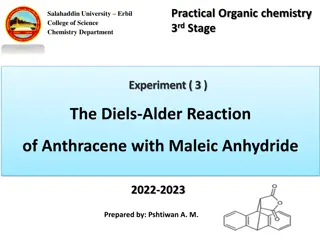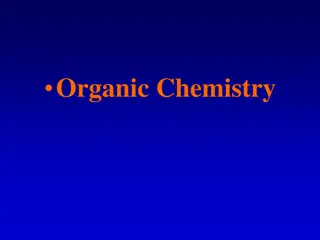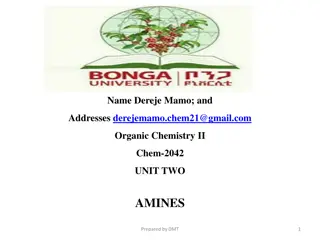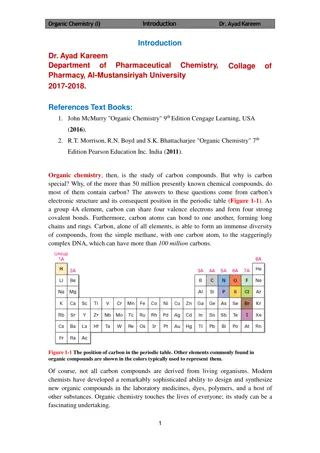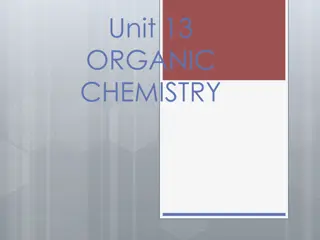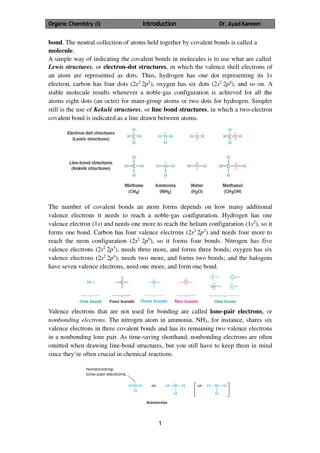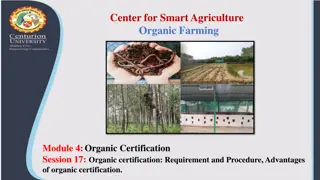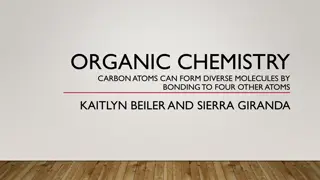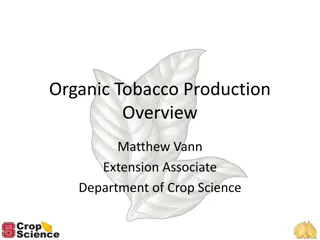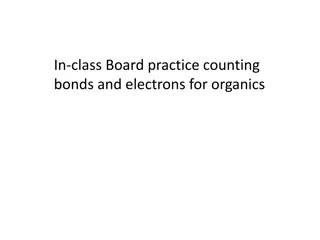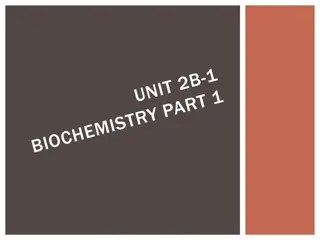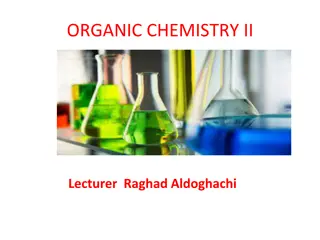Exploring the World of Organic Chemistry
Organic chemistry delves into the study of carbon compounds beyond just living organisms. With carbon's unique bonding capabilities, a vast array of useful compounds are created naturally and synthetically, shaping the foundation of modern chemistry. From hydrocarbons to complex structures like DNA and diamonds, the diversity and significance of organic compounds are boundless.
Download Presentation

Please find below an Image/Link to download the presentation.
The content on the website is provided AS IS for your information and personal use only. It may not be sold, licensed, or shared on other websites without obtaining consent from the author.If you encounter any issues during the download, it is possible that the publisher has removed the file from their server.
You are allowed to download the files provided on this website for personal or commercial use, subject to the condition that they are used lawfully. All files are the property of their respective owners.
The content on the website is provided AS IS for your information and personal use only. It may not be sold, licensed, or shared on other websites without obtaining consent from the author.
E N D
Presentation Transcript
What is organic chemistry? The name implies that it is the chemistry of living things That is partially true Organic chemistry- the study of carbon containing compounds (*with a few exceptions-like CO2) All living things are carbon based. However, carbon is not only involved in living things.
Why does carbon get its own class of chemistry? Since carbon can form 4 covalent bonds it has a large number of possibilities for structures. It also readily bonds with other carbon atoms forming chains or rings, which gives it billions of stable structures. Also, living things continuously do experiments making new carbon compounds.
because there are so many useful carbon compounds Chemistry is basically split into organic and inorganic. Carbon chemistry and everything else, and the everything else didn t really become important until recently. Since living things naturally make all of these carbon compounds, man found several uses for them without having to manufacture them.
Just a small sampling Some carbon compounds include DNA, diamonds, natural gas, aspirin, octane, polyester, freon, asphalt Caffeine, carbohydrates , plastics, rubber, acrylic, vinyl, graphite, proteins, propane Vinegar, citric acid, leather, TNT, alcohol, ibuprofen, soot, cellulose, butane etc. There are more known compounds of carbon than there are for all other elements combined!
Allotropes of pure carbon Allotrope- Different molecular structure of molecules containing the same atom Diamonds- dense tetrahedral network Graphite- layers laying on top of each other Buckminsterfullerene or buckyball ~ found in soot ( a sphere)
Simplest organic compounds Hydrocarbons- compounds containing carbon and hydrogen Alkanes- straight chain hydrocarbons with all single bonds Organic molecules follow their own system of nomenclature (naming) Alkanes get the suffix -ane
Naming and drawing organic compounds
Root words # of C atoms 1 # of C atoms 6 Meth Hex Eth 2 Hept 7 Prop 3 Oct 8 But 4 Non 9 Pent 5 Dec 10
So for example H H H H H-C-C-C-C-H H H H H H H H H H H H H H-C-C-C-C-C-C-C-C-H H H H H H H H H H H H H H-C-C-C-H H H H H-C-H H
So for example H H H H H-C-C-C-C-H H H H H butane H H H H H H H H H-C-C-C-C-C-C-C-C-H H H H H H H H H octane H H H H H-C-C-C-H H H H propane H-C-H H methane
Molecular Formulas Alkanes always have the molecular formula of: CxH2x+2 2 H on every C except the end, they get 3 Hexane- C6H14 molecular formula H H H H H H H H H H H H Structural Formula Lewis Dot, or H-C-C-C-C-C-C-H
Skeleton Formulas Drawing Lewis Dot structural formulas for long organic compounds can get rather tedious. So organic has shortened it They don t write the C s or the H s You draw a jagged line, at each corner there is a Carbon Assume all extra spaces are filled with H
For Example Heptane, C7H16 H H H H H H H = H-C-C-C-C-C-C-C-H H H H H H H H Nonane, C9H20 H H H H H H H H H H H H H H H H H H = H-C-C-C-C-C-C-C-C-C-H
Isomers Isomers- compounds with the same molecular formula but different structural formulas Different structural formulas mean it has different properties Butane is the first alkane with a possible isomer H-C-C-C-C-H H H H H or Both are C4H10 H H H H = H H H H-C- C - C-H H HCH H H
Naming Isomers Name the longest chain possible. As a prefix, name the chain attached with yl on the end and give the number of the carbon atom it is attached to 2 3 5 7 6 4 1 Longest Chain ethyl heptane 3 It could also be 5 ethyl heptane if you started numbering from the other side, when given an option always go with the Lower number!!!
Name this molecule And give its molecular formula
Name this molecule And give its molecular formula 4 ethyl octane C10H22 4 propyl decane C13H28
Cyclic Hydrocarbons A hydrocarbon that is a ring instead of a chain. To name it, give it the prefix cyclo- Molecular Formula Subtract 2 H from CxH2x+2 CxH2X cyclobutane H H C4H8 H-C-C-H H-C-C-H H H
Name the following compounds and give their formula
Name the following compounds and give their formula cycloheptane C7H14 cyclohexane C6H12 cyclooctane C8H16 cyclodecane C10H20
Name and give the formula Methyl cyclohexane C7H14
Alkenes Contain a double bond They get the suffix -ene and the number of the carbon atom the double bond is on (lowest number) Molecular formula Subtract 2 H for each double bond from CxH2x+2 H-C=C-C-C-H H H H Skeleton formula 1 butene H H H C4H8
Alkynes Contain a triple bond They get the suffix -yne and the number of the carbon atom the triple bond is on. Molecular formula subtract 4 H for each triple bond from CxH2x+2 Skeleton formula 2 pentyne H H H H-C-C=C-C-C-H H H H C5H8
Name and give the formula for these compounds
Name and give the formula for these compounds 2 hexene C6H12 Cyclopentane C5H10 3 methyl nonane C10H22 ethyne (commonly known as acetylene) C2H2 3 methyl 1 pentene C6H12
Name and give the formula for these compounds
Name and give the formula for these compounds 2 heptene C7H14 Cyclopentene C5H8 cyclopropane C3H6 1 butyne C4H6 3 ethyl 1 hexene C8H16
Doubles and triples If you have two of the same thing put di in front of it If you have three of the same thing put tri in front of it
Examples 2,3 hexadiene C6H10 3,4,4 trimethyl heptane C10H22
Multiple groups on a chain Name each and put the prefixes in alphabetical order
Multiple groups on a chain Name each and put the prefixes in alphabetical order 3, 4 diethyl 2 methyl 1 heptene C12H24

 undefined
undefined










